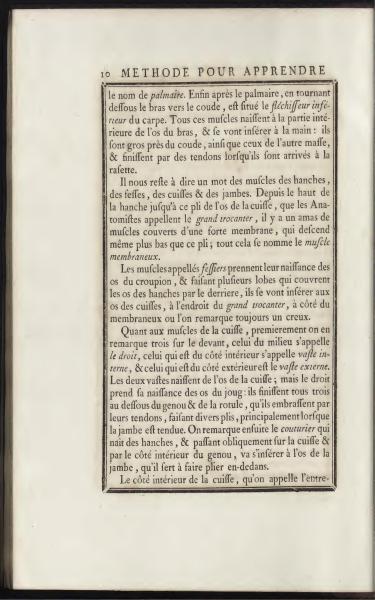METHOD FOR LEARNING
The name 'palmaris'. Finally, after the palmaris, turning under the arm towards the elbow, is the 'inferior flexor of the carpus'. All these muscles originate from the inside of the arm bone and attach to the hand: they are large near the elbow, like those of the other mass, and end in tendons when they reach the wrist.
We next need to mention the muscles of the hips, buttocks, thighs, and legs. From the top of the hip to the fold of the thigh bone, known as the 'greater trochanter' by anatomists, there is a mass of muscles covered by a strong membrane, extending even lower than this fold; this is called the 'membranous muscle'.
The muscles called 'gluteals' originate from the rump bones, forming several lobes that cover the hip bones at the back, and insert into the thigh bones, at the greater trochanter, next to the membranous area where a hollow is always noticeable.
Regarding the thigh muscles, we first note three in the front: the middle one is called 'rectus', the one on the inner side is 'vastus internus', and the one on the outer side is 'vastus externus'. The two vastus muscles originate from the thigh bone, but the rectus originates from the bones of the yoke: all three end below the knee and the kneecap, which they encircle with their tendons, forming various folds, especially when the leg is extended. Also noted is the 'sartorius', originating from the hips and running obliquely over the thigh and the inner side of the knee, inserting into the leg bone, aiding in internal leg bending.
The inner side of the thigh, known as the 'adductor',
Translation Notes
Palmaris: This refers to a group of muscles in the forearm.
Greater Trochanter: This is a prominent part of the femur near the hip.
Rectus: Known as 'rectus femoris', a muscle in the quadriceps group.
Gluteals: Refers to the gluteus muscles, involved in hip movement.
Sartorius: A long thin muscle running down the thigh, aiding in leg flexion.
